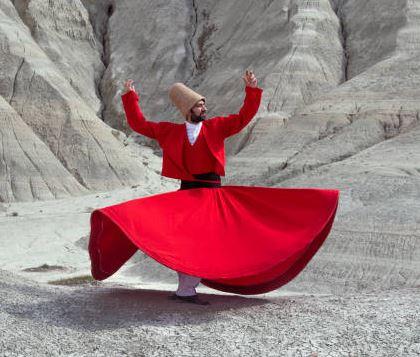Sufi

Sufism is the mystical branch of Islam, deeply focused on the inner, personal experience of the Divine. It's often described as the heart or soul of Islam, emphasizing love, devotion, and spiritual intimacy with God.
🌙 What is Sufism?
Sufism is a spiritual path that seeks to experience direct communion with God (Allah), often through practices that aim to purify the soul, transcend the ego, and deepen love and devotion. Sufis believe that true understanding of God comes from inner experience and spiritual insight, rather than just external practices or intellectual knowledge.
“We are the people of the heart, the people of the soul, not the people of the mind.” — Rumi (a famous Sufi mystic)
💖 Key Concepts in Sufism:
-
The Love of God:
Central to Sufism is the love for God. Sufis believe that God is Love, and to seek the Divine is to seek the deepest love. This love transcends the self, becoming a force that purifies the heart. -
Tawhid (Oneness of God):
Sufis believe in the oneness of God, seeing everything in the universe as interconnected through Divine unity. This oneness is both the basis of creation and the goal of spiritual union. -
The Inner Journey:
Sufism is about an inner transformation, where the ego (nafs) must be transcended to experience spiritual union with the Divine. This transformation involves a process of purification, which is why many Sufi practices focus on removing distractions and cultivating a direct, pure relationship with God. -
The Heart as the Center of Spirituality:
In Sufism, the heart is considered the center of all spiritual knowledge and the place where God’s presence is most directly felt. Opening the heart to God is a core goal of the Sufi path. -
Spiritual Mastery (Sheikh/Guide):
The role of a spiritual guide (Sheikh) is crucial in Sufism. The guide helps disciples navigate the complex inner journey and provides wisdom on how to open the heart to God.
🌟 Key Practices in Sufism:
-
Dhikr (Remembrance of God):
One of the primary practices of Sufis is dhikr, or the remembrance of God. This involves reciting divine names, phrases, or mantras (like "Allah" or "La ilaha illallah" — "There is no god but God"). The goal is to keep God in one’s heart and mind at all times. -
Sama (Listening to Divine Music):
Sufi practices often involve listening to music and chanting, particularly in the form of the Whirling Dervishes (a famous Sufi practice). The spinning dance is symbolic of the soul’s journey toward God, and the music helps to reach states of spiritual ecstasy. -
Whirling Dervishes:
This is the most famous Sufi practice, where practitioners spin in circles while reciting the name of God, creating a state of ecstasy and spiritual connection. The whirl symbolizes the soul's connection to the divine and the universe. -
Love and Service:
A significant aspect of Sufism is the love of others and service to the world. Sufis believe that one’s relationship with God is reflected in how they treat others, with the ultimate goal being to embody love, kindness, and humility. -
Poetry and Mysticism:
Sufi poets, like Rumi, Hafiz, and Saadi, have created a rich body of mystical poetry, exploring themes of divine love, the journey of the soul, and union with God. Their works are considered deeply spiritual and are often read as a form of prayer or meditation.
🌱 The Path to God in Sufism (The Sufi Journey):
Sufism is often described as a journey or path (known as the Tariqa) toward spiritual enlightenment and union with God. The path involves several stages or stations:
-
Fana (Annihilation of the Self):
The first stage involves the annihilation of the ego, or the self. Sufis believe that the individual’s ego must be dissolved for the soul to unite with God. This involves letting go of personal desires, attachments, and the illusions of the material world. -
Baqa (Spiritual Continuity):
After the ego is annihilated, the soul moves into a state of spiritual continuity with God. The person experiences a sense of oneness with the Divine. -
The Unveiling (Mushahada):
The ultimate goal is to see and experience the Divine directly. In this state of spiritual realization, the Sufi sees through the illusion of the material world and perceives the hidden presence of God in all things.
🌍 Sufism’s Influence:
-
Islamic Civilization:
Sufism has had a profound impact on Islamic culture, especially in terms of art, music, and literature. It has shaped Islamic mysticism, helping to create a rich tradition of thought and spiritual practice. -
Western Influence:
Sufi poets, especially Rumi, have had a significant influence on Western spirituality and literature. Rumi's poetry on divine love and the soul's longing for union with God has resonated deeply with readers worldwide, transcending religious boundaries. -
Modern Spirituality:
Sufism's focus on direct spiritual experience, love, and the inner journey resonates with many seekers in today’s world, particularly in the New Age and holistic spiritual communities.
✨ Sufi Mysticism and Spirituality:
Sufism is deeply mystical — it’s about experiencing God’s presence directly, often through personal, intimate practices. In this sense, Sufism represents a mystical union with the Divine, a journey into the sacred heart, and a way of being that transcends the boundaries of mind, self, and external religiosity.
The deeper spiritual practices in Sufism are profound tools to cultivate a closer, more intimate relationship with the Divine. They transcend the material world and aim to purify the heart and transcend the ego. These practices are designed to help the seeker experience direct communion with God, often moving through intense spiritual transformation.
Let’s explore some of the core Sufi spiritual practices in greater depth:
1. Dhikr (Remembrance of God)
Dhikr is one of the most fundamental practices in Sufism. The word itself means remembrance or recollection of God. The goal is to immerse the heart and mind in the Divine presence, keeping God constantly in the seeker’s thoughts and actions.
How it Works:
-
Reciting Divine Names: Sufis often recite names of God (e.g., "Allah," "Al-Rahman," "Al-Malik") in a rhythmic, repetitive manner.
-
Silent Dhikr: Some practitioners do dhikr silently in the heart, connecting internally with God.
-
External Dhikr: In group settings, practitioners often chant together aloud, using prayer beads (misbaha) to guide their recitations.
-
Purpose: The purpose is to purify the heart and cleanse the soul of distractions and attachments to the material world.
Benefits:
-
Mental Stillness: Helps quiet the mind, calming distractions and bringing focus to the Divine.
-
Heart Connection: Strengthens the emotional and spiritual connection to God.
-
Inner Peace: Reduces stress and cultivates tranquility, as one becomes absorbed in God’s presence.
2. Sama (Listening to Divine Music and Whirling)
Sama refers to the practice of listening to sacred music and participating in whirling (dance), both of which are designed to bring the practitioner into a state of ecstasy and spiritual union with God.
How it Works:
-
Sama is often performed by Whirling Dervishes, who spin in circles while listening to sacred music, particularly the sufi music with specific rhythms and melodies that facilitate spiritual connection.
-
The whirling dance is not just a physical movement — it’s symbolic of the soul’s spiritual ascent. The dancer whirls to let go of ego, moving toward spiritual oneness with the Divine.
-
The music, which includes flutes, drums, and chanting, enhances the spiritual journey, guiding the seeker into a state of mystical intoxication.
Benefits:
-
Spiritual Ecstasy: Through the dance and music, the practitioner enters a state of divine ecstasy, surrendering the self and opening to God’s presence.
-
Transcendence of Ego: The spinning represents the annihilation of the ego (fana), and the rhythm of the music helps the seeker focus on the Divine.
-
Mystical Unity: The dance is a physical representation of the spiritual journey toward unity with the Divine.
3. Muraqaba (Meditation and Contemplation)
Muraqaba means meditation or contemplation in Sufi practice. It involves deep inner reflection and focusing the mind on the Divine, often through visualization or conscious awareness of God’s presence.
How it Works:
-
Concentration on Divine Presence: The practitioner meditates on the presence of God, often visualizing the Divine light or focusing on a specific attribute of God (like Mercy, Love, or Beauty).
-
Contemplative Silence: It is often done in silence, creating a space for deep inner listening, where the practitioner attempts to align their heart with God's love and guidance.
-
Guided Meditation: In some cases, a spiritual guide (Sheikh) may lead the practitioner through guided meditation or give instructions on how to focus during the practice.
Benefits:
-
Clarity of Mind: Deep meditation helps quiet the mind, allowing one to hear the “whispers” of the Divine and gain spiritual insights.
-
Direct Experience: Through muraqaba, one can feel God’s presence and move toward personal revelations and experiences of the Divine.
-
Heart Cleansing: Meditation purifies the spiritual heart, helping to eliminate distractions and attachments.
4. Fana (Annihilation of the Self)
Fana is the ultimate goal of the Sufi path — the annihilation of the ego or self. It’s a process of losing oneself in the Divine, letting go of the false self and the illusions of the material world.
How it Works:
-
Through practices like dhikr, muraqaba, and other forms of spiritual purification, the seeker gradually releases the attachment to their own identity and desires.
-
The idea is to realize that the ego (nafs) is an illusion and that the true self is in union with God.
-
Fana involves transcending the individual self and merging into the Divine essence. It’s not a physical death but a spiritual death of the ego.
Benefits:
-
Spiritual Freedom: The ego is seen as the root of suffering, so fana allows the seeker to attain spiritual freedom and peace.
-
Union with God: Once the ego dissolves, the soul experiences direct unity with God (which is called baqa, the spiritual continuity).
-
Liberation: This practice leads to liberation from worldly attachments, suffering, and the illusion of separateness.
5. Sufic Retreat (Khalwa)
Khalwa is a practice of spiritual retreat, where the Sufi isolates themselves from the distractions of the world to focus solely on God. It is a form of seclusion designed for deep contemplation and purification.
How it Works:
-
The Sufi practitioner isolates themselves for a specific period of time, often in nature or in a secluded room (cell).
-
During this time, they engage in intense dhikr, prayer, and meditation without any interaction with the outside world.
-
The purpose is to purify the soul by shedding worldly attachments and entering a state of pure awareness of God.
Benefits:
-
Intensified Focus: The retreat allows for deeper immersion in the spiritual practices without worldly distractions.
-
Personal Revelation: Khalwa can be a time of spiritual breakthroughs where the seeker experiences personal revelations and deeper awareness of the Divine.
-
Inner Peace: Being in a quiet, sacred space enhances the peace that comes from spiritual connection.
🌿 Integration of Practices into Daily Life:
While these spiritual practices are intense, they are ultimately aimed at integrating Divine love and wisdom into the practitioner’s daily life. The goal of Sufism is not to retreat from the world, but to engage with it from a deeper, purified state of consciousness. The heart becomes the center of all actions — love, service, and kindness toward others become expressions of the Divine presence.

